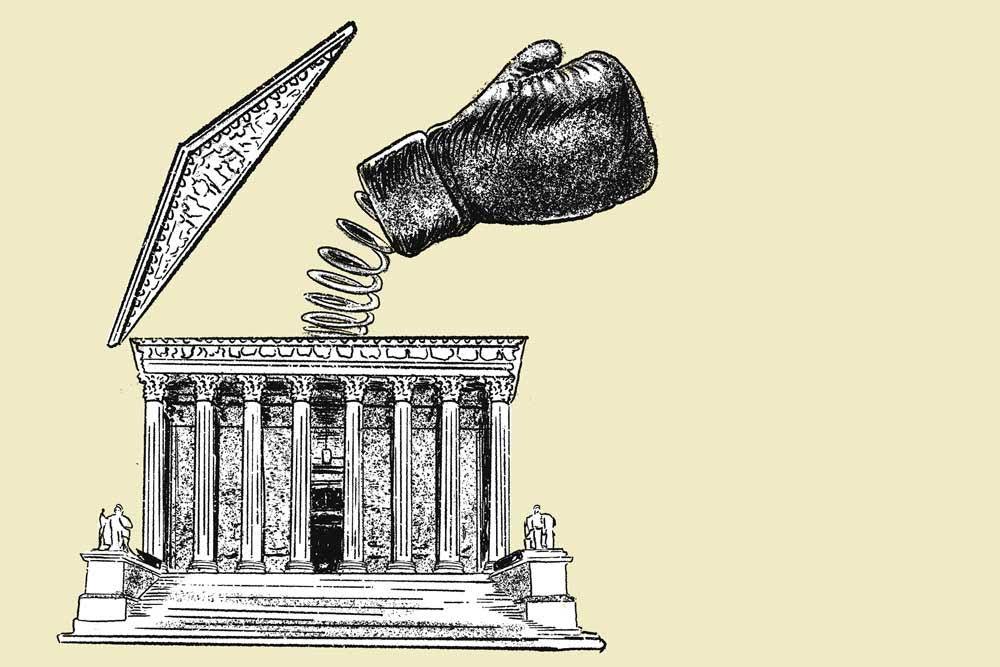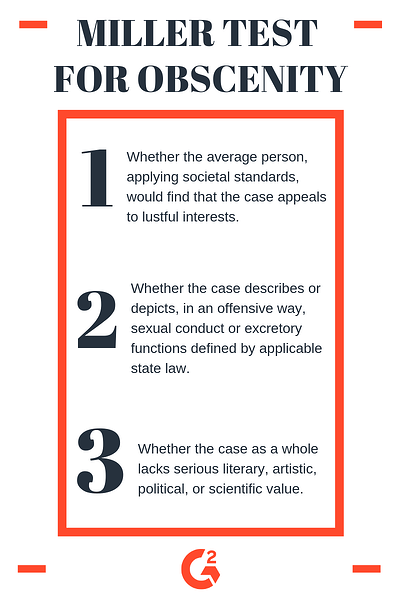Obscenity and Pornography
Obscenity refers to a narrow category of pornography that violates contemporary community standards and has no serious literary, artistic, political or scientific value. For adults at least, most pornography — material of a sexual nature that arouses many readers and viewers — receives constitutional protection. However, two types of pornography receive no First Amendment protection: obscenity and child pornography. Sometimes, material is classified as “harmful to minors” (or obscene as to minors), even though adults can have access to the same material.
Obscenity is a confounding area of First Amendment law
Obscenity remains one of the most controversial and confounding areas of First Amendment law, and Supreme Court justices have struggled mightily through the years to define it. Justice Potter Stewart could provide no definition for obscenity in Jacobellis v. Ohio (1964), but he did exclaim: “I know it when I see it.” Stewart found that the Court was “faced with the task of trying to define what may be indefinable.” In a later case, Interstate Circuit, Inc. v. Dallas (1968), Justice John Marshall Harlan II referred to this area as the “intractable obscenity problem.”

The Hicklin rule was a broad and suppressive test
Several early U.S. courts adopted a standard for obscenity from the British case Regina v. Hicklin (1868). The Hicklin rule provided the following test for obscenity: “whether the tendency of the matter . . . is to deprave and corrupt those whose minds are open to such immoral influences, and into whose hands a publication of this sort may fall.”
This test allowed material to be declared obscene based on isolated passages of a work and its effect on particularly susceptible persons. Using this broad test, the British court ruled obscene books deemed to be anti-religious. The two major problems with the Hicklin test were that it allowed works to be judged obscene based on isolated passages, and it focused on particularly susceptible persons instead of reasonable persons. This focus led to suppression of much free expression.
Roth test applied contemporary community standards in determining obscenity
The Supreme Court squarely confronted the obscenity question in Roth v. United States (1957), a case contesting the constitutionality of a federal law prohibiting the mailing of any material that is “obscene, lewd, lascivious, or filthy . . . or other publication of an indecent character.” The Court, in an opinion drafted by Justice William J. Brennan Jr., determined that “obscenity is not within the area of constitutionally protected speech or press.”
He articulated a new test for obscenity: “whether to the average person, applying contemporary community standards, the dominant theme of the material taken as a whole appeals to the prurient interest.” The Roth test differed from the Hicklin test in that it focused on “the dominant theme” of the material as opposed to isolated passages and on the average person rather than the most susceptible person.

Brennan articulated a new test
The Court struggled with obscenity cases through the 1960s and 1970s. In Memoirs v. Massachusetts (1966), a plurality of the Court, in an opinion by Justice Brennan, articulated a new three-part test:
- “(a) the dominant theme of the material taken as a whole appeals to a prurient interest in sex;
- (b) the material is patently offensive because it affronts contemporary community standards relating to the description or representation of sexual matters;
- and (c) the material is utterly without redeeming social value.”
The Miller test is now the leading test for obscenity cases
In the 1970s, the Burger Court determined that the obscenity standard was too rigid for prosecutors. Therefore, in Miller v. California (1973) the Court adopted a new three-part test — what Chief Justice Warren E. Burger called “guidelines” for jurors — that was more favorable to the prosecution:
- (1) whether the average person, applying contemporary community standards, would find that the work, taken as a whole, appeals to the prurient interest;
- (2) whether the work depicts or describes, in a patently offensive way, sexual conduct specifically defined by the applicable state law;
- and (3) whether the work, taken as a whole, lacks serious literary, artistic, political, or scientific value.
In Miller, the Court reasoned that individuals could not be convicted of obscenity charges unless the materials depict “patently offensive hard core sexual conduct.” Under that reasoning, many sexually explicit materials — pornographic magazines, books, and movies — are not legally obscene. Ironically, Justice Brennan dissented in Miller and Paris Adult Theatre I v. Slaton (1973), changing his position on obscenity. He determined that obscenity laws were too vague and could not be applied without “jeopardizing fundamental First Amendment values.”
The contemporary community standards prong of the Miller test is confusing in the Internet Age
The Miller test remains the leading test for obscenity cases, but it continues to stir debate. In its 1987 decision in Pope v. Illinois (1987), the Court clarified that the “serious value” prong of the Miller test was not to be judged by contemporary community standards. Obscenity prosecutions do, however, impose contemporary community standards, even though a distributor may transport materials to various communities. Thus interesting issues emerge when a defendant in California is prosecuted in a locale with more restrictive community standards.
This phenomenon has caused some legal experts and interested observers to call for the creation of a national standard, particularly in the age of the Internet. In Ashcroft v. American Civil Liberties Union (2002), several justices expressed concern about applying local community standards to the Internet as required by the Child Online Protection Act of 1998. For example, Justice Stephen G. Breyer wrote in his concurring opinion that “to read the statute as adopting the community standards of every locality in the United States would provide the most puritan of communities with a heckler’s veto affecting the rest of the Nation.” Similarly, Justice Sandra Day O’Connor, in her concurrence, wrote that “adoption of a national standard is necessary in my view for any reasonable regulation of Internet obscenity.”

The Court has resisted categorizing violence as obscenity
The Supreme Court has resisted efforts to extend the rationale of obscenity from hard-core sexual materials to hard-core violence. The state of California sought to advance the concept of violence as obscenity in defending its state law regulating the sale or rental of violent video games to minors. The Court invalidated the law in Brown v. Entertainment Merchants Association (2011), writing that “violence is not part of the obscenity that the Constitution permits to be regulated.”
Federal and state obscenity prosecutions have continued
Federal obscenity prosecutions increased during the George W. Bush administration. States continued to pursue obscenity prosecutions against hard-core pornography, but also occasionally against other materials. For example, in 1994 a comic book artist was convicted of obscenity in Florida, and in 1999 the owner of gay bar in Nebraska was successfully prosecuted for displaying a gay art in a basement. Although obscenity laws have their critics, they likely will remain part of the legal system and First Amendment jurisprudence.
While federal obscenity prosecutions waned during the Barack Obama administration, state obscenity prosecutions continue in the 21st century. In this light, Professor Jennifer Kinsley refers to the argument that obscenity law is a thing of the past as “the myth of obsolete obscenity.”
David L. Hudson, Jr. is a law professor at Belmont who publishes widely on First Amendment topics. He is the author of a 12-lecture audio course on the First Amendment entitled Freedom of Speech: Understanding the First Amendment (Now You Know Media, 2018). He also is the author of many First Amendment books, including The First Amendment: Freedom of Speech (Thomson Reuters, 2012) and Freedom of Speech: Documents Decoded (ABC-CLIO, 2017). This article was originally published in 2009.
cited https://mtsu.edu/first-amendment/article/1004/obscenity-and-pornography
To Learn More…. Read MORE Below and click the links
Learn More About True Threats Here below….
We also have the The Brandenburg v. Ohio (1969) – 1st Amendment
CURRENT TEST = We also have the The ‘Brandenburg test’ for incitement to violence – 1st Amendment
We also have the The Incitement to Imminent Lawless Action Test– 1st Amendment
We also have the True Threats – Virginia v. Black is most comprehensive Supreme Court definition – 1st Amendment
We also have the Watts v. United States – True Threat Test – 1st Amendment
We also have theClear and Present Danger Test – 1st Amendment
We also have theGravity of the Evil Test – 1st Amendment
We also have the Elonis v. United States (2015) – Threats – 1st Amendment
Learn More About What is Obscene….
We also have the Miller v. California – 3 Prong Obscenity Test (Miller Test) – 1st Amendment
We also have the Obscenity and Pornography – 1st Amendment
Learn More About Police, The Government Officials and You….
We also have theBrayshaw v. City of Tallahassee – 1st Amendment – Posting Police Address
We also have thePublius v. Boyer-Vine –1st Amendment – Posting Police Address
We also have the Lozman v. City of Riviera Beach, Florida (2018) – 1st Amendment – Retaliatory Police Arrests
We also have the Nieves v. Bartlett (2019) – 1st Amendment – Retaliatory Police Arrests
We also have the Freedom of the Press – Flyers, Newspaper, Leaflets, Peaceful Assembly – 1st Amendment
We also have the Insulting letters to politician’s home are constitutionally protected, unless they are ‘true threats’ – 1st Amendment
We also have the Introducing TEXT & EMAILDigital Evidencein California Courts – 1st Amendment
We also have the First Amendment Encyclopedia very comprehensive – 1st Amendment
ARE PEOPLE LYING ON YOU? CAN YOU PROVE IT? IF YES…. THEN YOU ARE IN LUCK!
We also have the Penal Code 118 PC – California Penalty of “Perjury” Law
We also have theFederal Perjury – Definition by Law
We also have the Penal Code 132 PC – Offering False Evidence
We also have the Penal Code 134 PC – Preparing False Evidence
We also have thePenal Code 118.1 PC – Police Officers Filing False Reports
We also have the Spencer v. Peters– Police Fabrication of Evidence – 14th Amendment
We also have the Penal Code 148.5 PC – Making a False Police Report in California
We also have the Penal Code 115 PC – Filing a False Document in California
Know Your Rights Click Here (must read!)
Under 42 U.S.C. $ection 1983 – Recoverable Damage$
42 U.S. Code § 1983– Civil Action for Deprivation of Right$
$ection 1983 Lawsuit – How to Bring a Civil Rights Claim
18 U.S. Code § 242 – Deprivation of Right$ Under Color of Law
18 U.S. Code § 241 – Conspiracy against Right$
$uing for Misconduct – Know More of Your Right$
Police Misconduct in California – How to Bring a Lawsuit
New Supreme Court Ruling – makes it easier to sue police
RELATIONSHIPWITH YOURCHILDREN& YOURCONSTITUIONAL RIGHT$ + RULING$
YOU CANNOT GET BACK TIME BUT YOU CAN HIT THOSE PUNKS WHERE THEY WILL FEEL YOU = THEIR BANK
We also have the 9.3 Section 1983 Claim Against Defendant as (Individuals) — 14th Amendment thisCODE PROTECTS all US CITIZENS
We also have the Amdt5.4.5.6.2 – Parental and Children’s Rights 5th Amendment thisCODE PROTECTS all US CITIZENS
We also have the 9.32 – Interference with Parent / Child Relationship – 14th Amendment thisCODE PROTECTS all US CITIZENS
We also have the California Civil Code Section 52.1Interference with exercise or enjoyment of individual rights
We also have the Parent’s Rights & Children’s Bill of RightsSCOTUS RULINGS FOR YOUR PARENT RIGHTS
We also have a SEARCH of our site for all articles relatingfor PARENTS RIGHTS Help!
Contesting / Appeal an Order / Judgment / Charge
Options to Appealing– Fighting A Judgment Without Filing An Appeal Settlement Or Mediation
Cal. Code Civ. Proc. § 1008 Motion to Reconsider
Penal Code 1385 – Dismissal of the Action for Want of Prosecution or Otherwise
Penal Code 1538.5 – Motion To Suppress Evidence in a California Criminal Case
CACI No. 1501 – Wrongful Use of Civil Proceedings
Penal Code “995 Motions” in California – Motion to Dismiss
WIC § 700.1 – If Court Grants Motion to Suppress as Evidence
 Epic Criminal / Civil Rights SCOTUS Help – Click Here
Epic Criminal / Civil Rights SCOTUS Help – Click Here
 Epic Parents SCOTUS Ruling – Parental Rights Help – Click Here
Epic Parents SCOTUS Ruling – Parental Rights Help – Click Here

